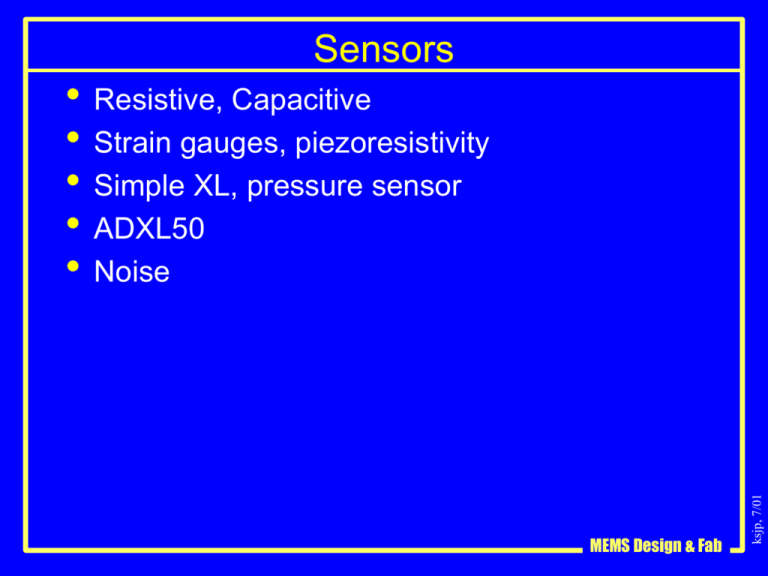Sensors2sub
advertisement

Sensors MEMS Design & Fab ksjp, 7/01 • Resistive, Capacitive • Strain gauges, piezoresistivity • Simple XL, pressure sensor • ADXL50 • Noise Resistive sensors • R(x) = R0(1+ax) Vx • Generate thermal noise • Wheatstone bridge minimizes sensitivity to • Nominal resistance value • Power supply variation • Other inputs • R(x) = R0(1+ax) (1+by) R0 V+ R(x) R0 VR0 MEMS Design & Fab ksjp, 7/01 • E.g. TCR, gauge factor Capacitive sensors • Typically used to measure displacement • C ~= e0 A/d • Can be used in Wheatstone bridge (with AC • Typically want amplifier very close • Typically need to shield other varying conductors • Definitely don’t want charge-trapping dielectrics nearby • No intrinsic noise Area (A) Separation (d) MEMS Design & Fab ksjp, 7/01 • excitation) Sensitive to environmental coupling Strain Sensors • Shape change • • • dL/L = e da/a = -ne (Poisson’s ratio) R(a,b,L) = r L/A R(e) = R0(1+(1+2n) e ) R(e) = R0(1+G e ) • Piezoresistive F F • Piezoelectric • Strain generates charge, charge generates strain MEMS Design & Fab ksjp, 7/01 r(e) = r0(1+ GP e ) • R(e) = R0(1+(GP+G) e ) • GP ~ -20, 30 (poly), ~100 (SCS) MEMS Design & Fab ksjp, 7/01 Simple piezoresistive pressure sensor MEMS Design & Fab ksjp, 7/01 Simple piezoresistive accelerometer Simple capacitive accelerometer C(x)=C(x(a)) • • • Cap wafer may be micromachined silicon, pyrex, … Serves as over-range protection, and damping Typically would have a bottom cap as well. MEMS Design & Fab ksjp, 7/01 Cap wafer Simple capacitive pressure sensor MEMS Design & Fab ksjp, 7/01 C(x)=C(x(P)) ADXL50 Accelerometer • +-50g • Polysilicon MEMS Design & Fab ksjp, 7/01 • MEMS & BiCMOS 3x3mm die ADXL50 Sensing Mechanism • Balanced differential capacitor output Under acceleration, capacitor plates move changing capacitance and hence output voltage On-chip feedback circuit drives on-chip forcefeedback to re-center capacitor plates. MEMS Design & Fab ksjp, 7/01 • • MEMS Design & Fab ksjp, 7/01 Analog Devices Polysilicon MEMS MEMS Design & Fab ksjp, 7/01 ADXL50 – block diagram MEMS Gyroscope Chip Proof Mass Sense Circuit Electrostatic Drive Circuit J. Seeger, X. Jiang, and B. Boser MEMS Design & Fab ksjp, 7/01 Rotation induces Coriolis acceleration Digital Output J. Seeger, X. Jiang, and B. Boser MEMS Design & Fab ksjp, 7/01 MEMS Gyroscope Chip Thermal Noise • Fundamental limitation to sensor • performance due to thermal noise “White” noise, Johnson noise, Brownian motion all the same • Not the same as flicker, popcorn, 1/f noise • Equipartition theorem (energy perspective) • every energy storage mode will have ½ kBT of energy • Every dissipator will contribute PN = 4 kBT B • B = bandwidth of interest in Hz MEMS Design & Fab ksjp, 7/01 • Nyquist (power perspective): Equipartition • ½ kBT = 4x10-21 J @ room temperature (300K) • ½ C V2 = ½ kBT • C=1pF Vn = 60uV (RMS value) • ½ k x2 = ½ kBT • K = 1N/m xn = 0.06nm • ½ m v 2 = ½ k BT MEMS Design & Fab ksjp, 7/01 • m = 10-9 kg (~100um cube) vn = 2x10-6 m/s • PN = 4 kBT B • In a resistor PN = VN2/R = 4 kBT B VN = sqrt(4 kBT R B) = sqrt (4 kBT R) sqrt(B) If R = 1kZ then VN = 4nV/sqrt(Hz) sqrt(B) MEMS Design & Fab ksjp, 7/01 • • • • • Nyquist Sensor and interface electronics Analog to Digital Converter Low noise amplifier m V transducer LNA ADC N Filter MEMS Design & Fab ksjp, 7/01 measurand Summary • Resistive and capacitive sensors most • MEMS Design & Fab ksjp, 7/01 • common Sensing, amplification, filtering, feedback on the same chip ~$2 Minimum detectable signal limited by thermal noise



